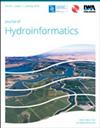基于模型的配水管网渗漏定位对水需求采样率和时空数据缺口的敏感性
IF 2.2
3区 工程技术
Q3 COMPUTER SCIENCE, INTERDISCIPLINARY APPLICATIONS
引用次数: 0
摘要
基于模型的配水管网渗漏定位需要对节点需水量进行精确估算,以正确模拟水力条件。虽然安装在住户家中的数字水表可以提供高分辨率的需水量信息,但在有效进行渗漏定位时,需水量数据所需的时间分辨率会产生问题。此外,时间和空间数据差距对漏点定位性能有何影响?为了解决这些研究空白,首先使用随机水终端使用模型 PySIMDEUM 对现实世界的配水管网进行了扩展。然后,根据不同的水需求采样分辨率、数据缺口率、泄漏规模、分析时间和数据估算方法,研究了 700 多种泄漏定位评估方案。数值结果表明,在需求量大/高峰期,需要较高的时间分辨率(如 15 分钟或更低)才能成功定位漏点。然而,无论采样频率如何,在低需水量期间,利用敏感性分析进行渗漏定位都能取得良好的效果(定位成功率平均为 95%)。此外,渗漏定位的改进可能取决于数据缺口管理所选择的数据估算方法,因为这些 方法可以缓解需水量的随机/突然时空波动。本文章由计算机程序翻译,如有差异,请以英文原文为准。
Sensitivity of model-based leakage localisation in water distribution networks to water demand sampling rates and spatio-temporal data gaps
Model-based leakage localisation in water distribution networks requires accurate estimates of nodal demands to correctly simulate hydraulic conditions. While digital water meters installed at household premises can be used to provide high-resolution information on water demands, questions arise regarding the necessary temporal resolution of water demand data for effective leak localisation. In addition, how do temporal and spatial data gaps affect leak localisation performance? To address these research gaps, a real-world water distribution network is first extended with the stochastic water end-use model PySIMDEUM. Then, more than 700 scenarios for leak localisation assessment characterised by different water demand sampling resolutions, data gap rates, leak size, time of day for analysis, and data imputation methods are investigated. Numerical results indicate that during periods with high/peak demand, a fine temporal resolution (e.g., 15 min or lower) is required for the successful localisation of leakages. However, regardless of the sampling frequency, leak localisation with a sensitivity analysis achieves a good performance during periods with low water demand (localisation success is on average 95%). Moreover, improvements in leakage localisation might occur depending on the data imputation method selected for data gap management, as they can mitigate random/sudden temporal and spatial fluctuations of water demands.
求助全文
通过发布文献求助,成功后即可免费获取论文全文。
去求助
来源期刊

Journal of Hydroinformatics
工程技术-工程:土木
CiteScore
4.80
自引率
3.70%
发文量
59
审稿时长
3 months
期刊介绍:
Journal of Hydroinformatics is a peer-reviewed journal devoted to the application of information technology in the widest sense to problems of the aquatic environment. It promotes Hydroinformatics as a cross-disciplinary field of study, combining technological, human-sociological and more general environmental interests, including an ethical perspective.
 求助内容:
求助内容: 应助结果提醒方式:
应助结果提醒方式:


